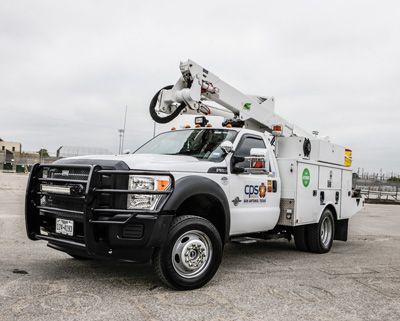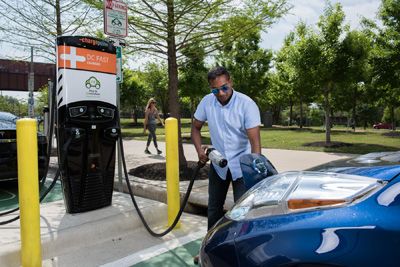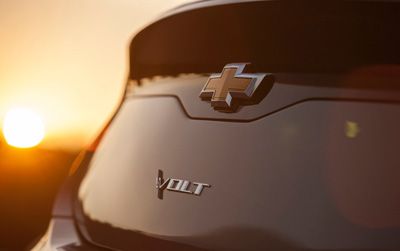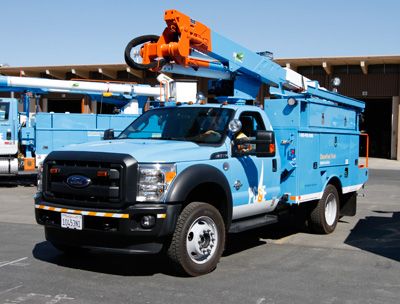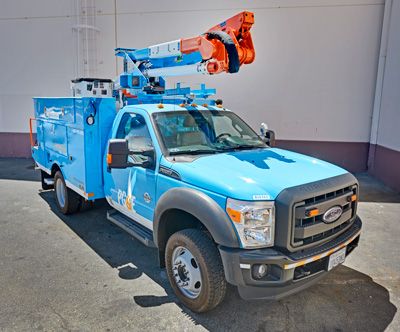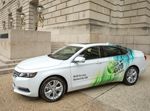Support Grows for EEI White Paper on Utility Fleets and Electrification
As part of an effort to advance sustainability through fleet adoption of electric vehicles, the Edison Electric Institute has released a white paper, “Transportation Electrification: Utility Fleets Leading the Charge,” that focuses on the electric power industry’s effort to accelerate the expansion of electric transportation in commercial and retail markets, beginning with electric utility fleets.
Written by EEI’s Fleet Electrification Steering Committee comprised of utility fleet directors from across the country, the paper encourages investor-owned electric utilities to meet an industry-wide goal to spend at least 5 percent of annual fleet acquisition budgets on plug-in electric vehicles (PEVs) and technologies. According to the paper, electrification of the transportation sector is a potential quadruple win for electric utilities and society, potentially enabling electric utilities to support environmental goals, build customer satisfaction, reduce operating costs and assure the future value of existing assets.
The EEI white paper elaborates on the business case for utility fleet electrification as well as the full range of PEVs available for adoption in fleets. It shows that electrification of large utility fleets offers benefits that range from lower operating costs from fuel and maintenance, to extended vehicle life based on their mechanical simplicity, as well as reduced carbon footprint and toxic emissions.
“The electric power industry is a tremendous leader in supporting electric transportation, but we must continue to strengthen our efforts and lead by example,” said EEI President Tom Kuhn. “One way we can do that is by leveraging our industry’s buying power to purchase more PEVs for our fleets. The white paper is a road map for a long-term, coordinated effort to further spur the development of electric vehicle technologies in the transportation market.”
The NAFA Fleet Management Association extended its support to EEI. “This year, NAFA introduced the Sustainable Fleet Standard Program to our membership, and we are in the final stages of its beta phase,” said NAFA President Claude A. Masters, manager, acquisition and fuel at Florida Power & Light. “While NAFA has a fuel-neutral philosophy, the association recognizes that electric vehicles will be a major player in how fleets will reach carbon footprint goals.”
Pacific Gas and Electric Co. also joined with EEI to urge utilities to more than double their current investment in electric utility fleet vehicles. Over the past five years, PG&E noted, the industry has invested approximately $85 million incorporating PEV technologies into utility fleets, or about 1.7 percent of overall utility fleet spending. PG&E and EEI are calling on companies to raise that investment to 5 percent of their total fleet investment, or approximately $1 billion, starting next year.
“Expanding the use of plug-in technologies is one of the most important opportunities we have as a country to continue diversifying our energy usage and achieve our clean energy goals,” said PG&E Chairman and CEO Tony Earley. “Electrifying our fleets is about showing consumers that plug-in technology is thriving and delivers real benefits that make sense for us and our customers.”
PG&E operates the nation’s largest fleet of alternative fuel vehicles and tops the industry with 14 percent of its fleet investment dedicated to plug-in technologies. PG&E’s PEV technology includes electric power-takeoff systems on the utility’s bucket trucks. This technology allows crews to operate all onboard equipment, including the aerial device and auxiliary systems, via a series of batteries, eliminating the need to idle the trucks at work sites. In addition, last year PG&E acquired the utility industry’s first plug-in electric Class 5 utility work trucks from Electric Vehicles International.
“Our experience has confirmed that the business case for fleet electrification is solid,” said Dave Meisel, senior director of transportation services for PG&E. “We are seeing full payback on the increased initial investment in less than five years in most cases. In addition to the fuel savings, we’re seeing dramatically lower vehicle emissions and a better on-the-job experience for our crews.”
EEI has also formed an Electrification Task Force designed to provide technical expertise and share industry best practices and case studies from utilities that have emerged as leaders in fleet electrification. Visit www.eei.org.
Volt Surpasses Half a Billion Electric Miles
Since its launch in late 2010, Chevrolet Volts have traveled more than half a billion all-electric miles. Additionally, based on a General Motors study of more than 300 Volts in service in California for more than 30 months, many users are exceeding the EPA rating of 35 miles of electric vehicle range per full charge, with about 15 percent surpassing 40 miles of range.
Volts that are charged regularly, according to GM, typically drive more than 970 miles between gasoline fill-ups. The 2014 Volt model provides fuel economy of EPA-estimated 98 MPGe (electric) and 35 city/40 highway on gasoline power. In an independent study conducted between July and December 2013, Volt drivers who participated in the Department of Energy’s EV Project managed by Idaho National Labs totaled 1,198,114 vehicle trips, of which 974,692 – or 81.4 percent – were completed without the gasoline-powered generator being used. Visit www.chevrolet.com.
HYBRID NEWS
Understanding PHEV Options
Joe Dalum, president and CEO of Odyne Systems, a manufacturer of hybrid systems for medium- and heavy-duty work trucks, delivered a presentation explaining plug-in electric vehicle technology options for truck fleets at Plug-In 2014 in San Jose, Calif. Dalum’s presentation discussed the medium- and heavy-duty truck market, fleet strategy, vehicle duty cycles and how to select the best plug-in hybrid electric vehicle (PHEV) solution.
During his presentation, Dalum stressed the importance of duty cycle data acquisition and analysis for determining if a PHEV system is a good fit for a fleet’s vehicle use strategy. He discussed the Green Truck Association’s Hybrid Work Truck Payback Worksheet and other considerations such as EPAct credits, work site safety and ROI, along with factors for comparing hybrid, electric power-takeoff or PHEV solutions, including warranty, safety, performance and applications. Visit www.odyne.com.
DUECO Delivers to PECO
Philadelphia-based PECO, an electric and natural gas utility subsidiary of Exelon Corp. that serves 1.6 million electric and more than 500,000 natural gas customers in southeastern Pennsylvania, has taken delivery of the first of 22 new Terex XT55 bucket trucks with Odyne hybrid power systems supplied by DUECO Inc., a provider of Terex Utilities and Terex Hi-Ranger products.
The 22 trucks are part of a 300-vehicle, $45.4-million U.S. Department of Energy, Electric Power Research Institute and South Coast Air Quality Management District of California award. Odyne is developing and deploying more than 120 plug-in hybrid systems for companies and governmental entities throughout North America as part of the program. The trucks delivered to PECO feature the capability to charge the hybrid batteries at the most opportune time, reducing charging costs and excess demand on the utility grid.
“We are proud to be the first utility in the United States to deploy this type of vehicle through the combined Department of Energy and Electric Power Research Institute initiative,” said PECO President and CEO Craig Adams. “In addition to our core mission of providing safe and reliable service to our customers, PECO and all of Exelon share a strong commitment to protecting and preserving the environment, and operating a sustainable fleet is a key component of our efforts.” Visit www.dueco.com.
Freightliner Hybrid-Electric Trucks Approved for Incentive Program
The Freightliner M2 106 diesel-electric hybrid truck has been approved for the New York Truck-Voucher Incentive Program (NYT-VIP). In partnership with the New York State Energy Research and Development Authority, New York State Department of Transportation, New York City Department of Transportation and CALSTART, NYT-VIP provides $19 million in incentives for clean vehicle technologies. The goal of the program is to promote clean air and a sustainable future for New York’s transportation system by accelerating the integration of advanced vehicle technologies in the commercial truck and bus sectors.
“Freightliner M2 106 hybrid trucks are a smart solution featuring innovative technologies that maximize productivity while also benefiting the environment,” said Mary Aufdemberg, director of product marketing for Freightliner Trucks. “Customers who take advantage of the New York Truck-Voucher Incentive Program will realize even more efficiencies that will help lower their overall cost of ownership.”
The Freightliner M2 106 diesel-electric hybrid truck can be configured for a wide variety of bodies for different applications, including utility vehicles. Visit www.freightlinertrucks.com.
NATURAL GAS NEWS
PERC Creates One-Stop Source for Propane Technology News
The Propane Education & Research Council has launched a new website, propane.com, as a source for information about propane safety and newly developed propane-powered technology.
“Propane.com gives our industry a chance to showcase the versatility of propane, and the economic and environmental benefits of using this American-made fuel across top-performing markets,” said Roy Willis, president and CEO of PERC. “The consolidation also gives propane customers the opportunity to realize all the technologies available for businesses.”
Propane.com consolidates information from PERC’s previous sites, including autogasusa.org, agpropane.com, poweredbypropane.com and usepropane.com. Fleets can also use the site’s Find a Propane Retailer application to locate fuel providers by zip code and services provided. Visit www.propane.com.
Quantum Announces New CNG Storage System Orders
Quantum Fuel Systems Technologies Worldwide has received approximately $600,000 in purchase orders from the WheelTime network for its lightweight natural gas storage systems. Quantum has been the exclusive supplier of compressed natural gas storage systems for aftermarket system conversions to the WheelTime Network, comprised of 18 member companies with more than 180 installation and service locations nationwide. The latest orders expand the relationship to include system installs on new trucks at WheelTime locations. Under an arrangement that began more than two years ago, Quantum and WheelTime have been training and educating the network locations on installs, maintenance and service.
“We are excited to be expanding this relationship with additional orders and especially to include additional WheelTime members and locations,” said Brian Olson, president and CEO of Quantum. “We are working closely with WheelTime on setting up new locations with installation and service training and to provide turnkey system solutions. Our goal is to have this relationship reach all 50 states.”
Quantum also announced it has received its first CNG storage system order from a large Kenworth dealership network with offices in the U.S. and Canada. The purchase order is for Quantum’s frame-rail mounted Q-RailLITE CNG storage vessels. Quantum will train dealerships to install and service the CNG modules.
A newly expanded purchase order from Westport for CNG tanks has also been received by Quantum. “We are expanding our relationship with Westport after being identified as a key fuel storage supplier for their natural gas vehicle programs,” Olson said. Visit www.qtww.com.
Fueling Park Operations with Propane
Mammoth Cave National Park has received a donation of propane-powered off-road and stationary equipment from the Propane Education & Research Council. The donation totals more than $62,000 and includes three John Deere zero-turn mowers, two Generac portable generators and a CleanFUEL USA propane dispenser featuring eConnect, a fuel network management system for electronic dispensers. MCNP also operates eight propane autogas Bluebird school buses and two propane autogas ROUSH CleanTech Ford F-250 pickup trucks.
“We’ve been dedicated to integrating sustainable practices into park operations for many years,” said Russell Runge, MCNP acting superintendent. “PERC’s donation of propane equipment will continue to help us reach our sustainability goals. Not only do the donations help MCNP become more environmentally friendly and better monitor fuel usage, but they also advance the National Park Service’s Green Parks Plan aimed at reducing dependence on foreign oil, mitigating effects of climate change and conserving energy.”
MCNP’s efforts in sustainability began in the late 1990s when it partnered with the Kentucky Clean Fuels Coalition, a Clean Cities Coalition partner. KCFC was instrumental in securing the donation of propane autogas buses. KCFC has been advocating for alternative fuel usage and supporting the National Park Service since the coalition was established in 1993. Visit www.propane.com.
CleanFUEL USA Liquid Propane Injection System Powers Freightliner Products
Full production has begun of two CleanFUEL USA liquid propane injection systems for Freightliner Custom Chassis Corp. S2G medium-duty trucks and Thomas Built C2 school buses. The factory-installed propane autogas systems require no aftermarket modifications.
The FCCC S2G truck and the Thomas Built Saf-T-Liner C2 school bus with the propane systems are powered by an 8-liter engine from Powertrain Integration and are equipped with an Allison 2300 automatic transmission. The engine is rated at 495 pound-feet of torque at 3,100 rpm and 339 horsepower at 4,100 rpm. Visit www.cleanfuelusa.com.
PERC Promotes Clean Propane on Campus
The Propane Education & Research Council has joined the Association for the Advancement of Sustainability in Higher Education to encourage low-emissions propane equipment use in higher education. Through the association of colleges and universities, PERC will inform higher education institutions about the benefits of using clean, low-emissions propane equipment as part of their sustainability initiatives.
“Propane is the leading alternative fuel in the U.S. and helps thousands of businesses, fleets, contractors, and consumers meet their economic and environmental goals,” said Roy Willis, PERC CEO and president. “We want to help bring the same fuel-efficient technologies to campuses through equipment demonstrations, incentives, and educational programs that will help AASHE members significantly reduce their carbon footprint and save money.”
AASHE enables colleges and universities to meet their sustainability goals by providing specialized resources, professional development and a network for sharing information. Many AASHE resources are free to the public, and its programs help support the American College & University Presidents’ Climate Commitment. ACUPCC institutions sign a commitment promising to lead their institutions toward climate neutrality. There are more than 650 ACUPCC signatories and 800-plus AASHE members to date.
“AASHE counts on the support of many innovative organizations, such as PERC, to fulfill our mission of creating a cleaner, greener and more sustainable planet, starting with college campuses,” said Stephanie A. Herrera, AASHE executive director. “AASHE business members support the sustainability movement by providing valuable products, services and resources to help move this vital community toward a better future.” Visit www.aashe.org.
Freightliner Trucks Adds to Natural Gas Options
The Cummins Westport ISX12 G heavy-duty natural gas engine will be available as a factory-installed option for the Freightliner 114SD severe-duty truck model in 2015. The 12-liter ISX12 G engine features ratings up to 400 horsepower and 1,450 pound-feet of torque, and operates on CNG or LNG. Factory-installed back-of-cab mounted CNG tanks are available in 60 and 75 diesel gallon equivalent configurations. The 114SD has been available with natural gas with the 9-liter Cummins Westport ISL G engine since 2011.
Freightliner’s commitment to green technologies is part of parent company Daimler AG’s global “Shaping Future Transportation” initiative. Launched in 2007, the initiative is focused on reducing criteria pollutants, carbon dioxide and fuel consumption through the utilization of clean, efficient drive systems including clean diesel and alternative fuels. Since 2008, Freightliner Trucks has sold more 3,500 natural gas-powered trucks and tractors. Visit www.freightlinertrucks.com.
Omnitek Receives EPA Approval for Mack Engine Conversions
Omnitek Engineering Corp. has received a Certificate of Conformity from the U.S. Environmental Protection Agency for diesel-to-natural-gas engine conversions of all Mack E7 electronic engines up to model year 2006. The approval allows engine conversions to proceed in 49 states and covers 166 Mack E7 engine/model/power variations.
Omnitek will offer 100 percent dyno-tested “drop-in” ready converted engines, configured for quick installation. An assembly line engine remanufacturing/conversion process performed by the company’s strategic partner Reviva will assure that engines are in as-new condition. The Omnitek diesel-to-natural-gas converted Mack E7 engine produces 400 horsepower with low nitrogen oxide emissions of 0.14 gr/bhp-hr, per the EPA SET emissions test protocol, without the use of EGR.
“There is significant pent-up demand for converting Mack E7 diesel engines to natural gas,” said Werner Funk, president and CEO of Omnitek. “Diesel-to-natural-gas engine conversions are a viable and cost-effective option for fleets to transition to natural gas within a practical time frame.
“As engines are converted to use 100 percent natural gas, the payback on a diesel-to-natural-gas truck conversion can be as short as 16 months, including the cost for the engine, fuel storage system and installation labor,” Funk added. “This is a significant improvement compared to diesel dual fuel technology.” Visit www.omnitekcorp.com.
Peterbilt Offers New Natural Gas Powertrain Option
For several of its natural gas vehicles, Peterbilt Motors Co. is now offering an automated transmission and a natural gas engine that can be powered by CNG or LNG. The Eaton UltraShift PLUS and Cummins Westport ISX12 G are available for Peterbilt Models 579, 567, 384 and 365.
The Eaton UltraShift PLUS is available in the 13-speed MHP and 10-speed LAS series, and the 11.9-liter Cummins Westport ISX12 G is available up to 400 horsepower and 1,450 pound-feet of torque. Visit www.peterbilt.com.
Mack Trucks Offers Grant Application Assistance
To help customers maximize their return on investment, Mack Trucks announced it is now working with the Sustainability Initiatives Group to help dealers and customers navigate the grant process and obtain public funding for alternative fuel- and clean diesel-powered vehicles. SIG will maintain an up-to-date inventory of federal and state grant information, offer summaries on relevant grant opportunities, and assist in the grant application and writing process. Visit www.macktrucks.com.
CLEAN DIESEL NEWS
Clean Diesel Trucks Make Up 33 Percent of All Trucks on U.S. Highways
More than one-third of all medium- and heavy-duty commercial trucks registered in the U.S.– 2.9 million of 8.8 million trucks – are now equipped with newer technology clean diesel engines, according to new data compiled by HIS Automotive for the Diesel Technology Forum (DTF). The new data includes registration information on Class 3-8 trucks from 2007 through 2013 in all 50 states and the District of Columbia.
Beginning in 2007, all heavy-duty diesel trucks sold had to meet particulate emissions levels of no more than 0.01 grams per brake horsepower hour. Emissions from today’s diesel trucks and buses are near zero thanks to more efficient engines, more effective emissions control technology and the nationwide availability of ultralow sulfur diesel fuel, DTF noted. The new clean diesel technology has reduced emissions from heavy-duty diesel trucks and buses by 99 percent for nitrogen oxides and 98 percent for particulate emissions. Visit www.dieselforum.org.
NAFA Requests Extension of Diesel Emissions Reduction Act
The Diesel Emissions Reduction Act (DERA), administered through the U.S. Environmental Protection Agency, provides up to $100 million each year through 2016 for reducing emissions from existing diesel engines. The EPA announced that roughly $9 million is still available for agencies seeking to undergo clean diesel projects, including replacement, repower and retrofit initiatives.
Recently, NAFA Fleet Management Association CEO Phillip Russo reached out to leaders in Washington urging continued funding for the DERA. “Millions of older diesel engines are still in use by fleets,” Russo said. “Thankfully, emissions from these older engines may be controlled with the use of modern control technologies that reduce emissions. If funds are not allowed to be appropriated for DERA, the administration’s 2015 budget proposal will reduce DERA funding from the $20 million contained in the continuing resolution in fiscal year 2014 to zero in 2015. We believe that modest increases in funding for DERA can and must be achieved within the framework of the overall budget agreement approved by Congress late last year, and encourage you to support $30 million in funding for fiscal year 2015.” Visit www.nafa.org.
GREEN EVENTS
Green Truck Summit & The Work Truck Show 2015
March 3-6
Indiana Convention Center
Indianapolis
www.ntea.com/worktruckshow


